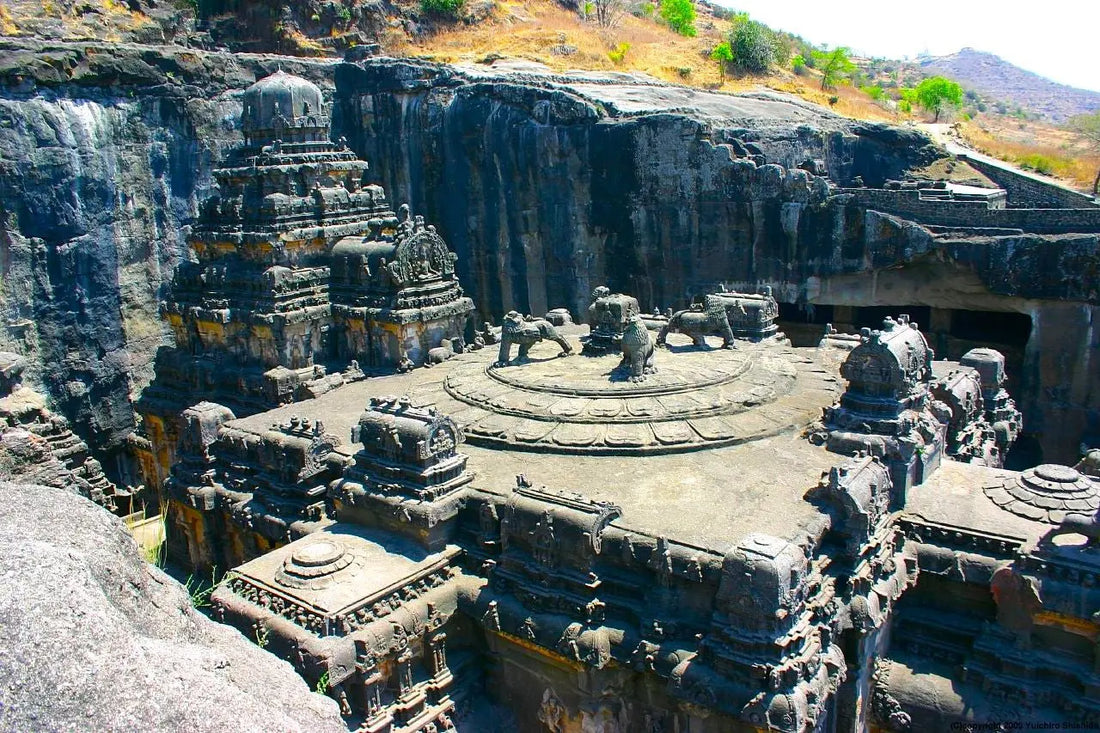
"The Majestic Kailash Temple: A Testament to Rock Craft and Spiritual Devotion"
Nestled in the heart of the Ellora Caves in Maharashtra, India, the Kailash Temple stands as one of the most awe-inspiring examples of rock-cut architecture in the world. This temple, dedicated to Lord Shiva, is not just a symbol of spiritual devotion but also a testament to the incredible craftsmanship of ancient Indian artisans. Carved out of a single massive rock, the Kailash Temple is a marvel of engineering, artistic vision, and religious dedication.

"Historical Background"
The construction of the Kailash Temple is believed to have been commissioned by the Rashtrakut king Krishna I in the 8th century CE. The temple is part of the Ellora Cave complex, a UNESCO World Heritage Site, which features 34 monasteries and temples, extending over more than 2 kilometers. What makes the Kailash Temple unique among these is its monolithic nature—entirely hewn from a single piece of rock.
The artisans of that era employed a top-down excavation method, starting from the summit and working their way down. This technique required precise planning and extraordinary skill, as any error could have led to the collapse of the entire structure. The sheer scale of the temple is mind-boggling, with its central shrine, towering gateway, massive pillars, and intricately carved sculptures, all executed with incredible precision.

"Architectural Grandeur"
The Kailash Temple is a perfect example of Dravidian architecture, with its towering vimana (spire), grand entrance, and intricately carved interiors. The temple's dimensions are staggering—about 98 feet in height, 164 feet in length, and 109 feet in width. Despite its massive size, the temple is adorned with intricate carvings depicting scenes from Hindu mythology, particularly the Ramayana and Mahabharata.
The temple's central shrine houses a Shiva lingam, symbolizing the sacred presence of Lord Shiva. Surrounding the main shrine are numerous smaller shrines, dedicated to various deities, as well as an expansive courtyard, where you can find life-sized statues of elephants and other animals, adding to the temple's grandeur.
One of the most remarkable features of the Kailash Temple is its vertical excavation technique. Unlike other rock-cut structures that were often carved into a hillside or a cliff, the Kailash Temple was carved downwards from a flat rock surface, making it one of the most ambitious rock-cut projects ever undertaken.

"Spiritual Significance"
The Kailash Temple is not just an architectural wonder; it is also a place of profound spiritual importance. Dedicated to Lord Shiva, the temple symbolizes Mount Kailash, the mythical abode of Shiva in Hindu tradition. Devotees believe that the temple is imbued with the presence of Shiva, and visiting it is considered a pilgrimage that brings one closer to the divine.
The temple's location within the Ellora Caves also highlights the syncretic nature of ancient Indian spirituality. The caves include not only Hindu temples but also Buddhist and Jain monasteries, reflecting a period of religious tolerance and cultural exchange. The proximity of these different religious structures within the same complex underscores the coexistence and mutual respect that characterized Indian spiritual life during this era.

"The Legacy of Kailash Temple"
The Kailash Temple has inspired awe and reverence for centuries. Its construction, requiring the removal of an estimated 200,000 tons of rock, remains a subject of wonder among historians, archaeologists, and engineers. The temple's intricate carvings and grand architecture continue to draw scholars and tourists from around the world.
Moreover, the Kailash Temple stands as a reminder of the incredible achievements of ancient Indian civilization. It is a testament to the ingenuity and devotion of the artisans who created it, as well as the spiritual vision that inspired its construction. The temple continues to be a vibrant place of worship, attracting thousands of pilgrims each year who come to pay homage to Lord Shiva and experience the temple's sacred aura.

"Conclusion"
The Kailash Temple is more than just a monument; it is a living embodiment of India's rich spiritual and cultural heritage. Its rock-cut grandeur and intricate craftsmanship are a testament to the heights of human creativity and devotion. As a place of worship and a symbol of spiritual aspiration, the Kailash Temple continues to inspire awe, devotion, and reverence in all who visit it.


